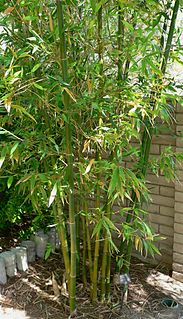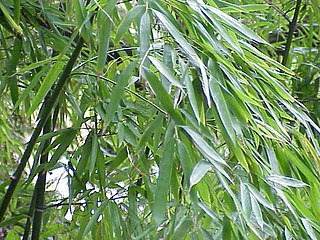
Bamboos are a diverse group of evergreen perennial flowering plants in the subfamily Bambusoideae of the grass family Poaceae. The origin of the word "bamboo" is uncertain, but it probably comes from the Dutch or Portuguese language, which originally borrowed it from Malay or Kannada.

Phyllostachys is a genus of Asian bamboo in the grass family. Many of the species are found in central and southern China, with a few species in northern Indochina and in the Himalayas. Some of the species have become naturalized in parts of Asia, Australia, the Americas, and southern Europe.

Phyllostachys nigra, commonly known as, black bamboo, is a species of bamboo, native to Hunan Province of China, and is widely cultivated elsewhere.

Cabot's tragopan is a pheasant found in south-east China. The common and scientific names of this large bird both commemorate the ornithologist Samuel Cabot III. Other common names include the Chinese tragopan and the yellow-bellied tragopan. The population is divided into two subspecies, of which the nominate race is found in the provinces of Fujian, Jiangxi, Zhejiang, and Guangdong, and T. c. guangxiensis is confined to northeastern Guangxi and southern Hunan. The IUCN has assessed it as being a "vulnerable species".

Phyllostachys aureosulcata, the yellow groove bamboo, is a species of bamboo native to the Zhejiang Province of China. It is a running bamboo with a distinctive yellow stripe in the culm groove that is often grown as an ornamental.

Anji County (help·info) is a county in the prefecture-level city of Huzhou in northwestern Zhejiang province, People's Republic of China, with a population of 461,800 as of the end of 2013. Anji county is well known for its 60,000 hectares of bamboo groves containing over 40 different species of bamboo. It has been designated a pilot county for ecological and green building construction.

Bambusa vulgaris, common bamboo, is an open-clump type bamboo species. It is native to Indochina and to the province of Yunnan in southern China, but it has been widely cultivated in many other places and has become naturalized in several regions. Among bamboo species, it is one of the largest and most easily recognized.
Phyllostachys heteroclada, the fishscale bamboo, also known as "water bamboo", is a running bamboo. The water bamboo name comes from the air canals in the rhizomes and roots that allow this bamboo to grow in more saturated conditions as compared to similar species. This species can also have abrupt kinks at the base of the culms. Maximum height can reach 35 ft with a diameter of 2 in. It is cold hardy to around -5 °F. It grows well in USDA zones 6b-10.
Phyllostachys atrovaginata is a running bamboo with strongly tapered, stiff, upright culms. It may reveal a fragrant scent during warm weather or when vigorously rubbed. The common name of "incense bamboo" comes from the unique aroma. Its culms grow large in diameter relative to height. Maximum height can reach 10 m (33 ft) with a maximum culm diameter of 7.0 cm (2.7 in). This bamboo grows in areas ranging from subtropical to temperate and tolerates winter temperatures down to -23 °C (-10 °F), being a more cold-hardy bamboo. Like water bamboo, the rhizomes and roots of this species also have air canals as an adaptation for living in wet soil. The specific epithet atrovaginata or "dark-sheathed" is inspired from the dark green and deep red wine colors of the culm sheaths. P. atrovaginata has formerly been called Phyllostachys congesta.

Phyllostachys rubromarginata, the reddish bamboo or red margin bamboo, is a species of Phyllostachys bamboo, native to Central China, specifically Guangxi and Guizhou.

Bambusa oldhamii, known as giant timber bamboo or Oldham's bamboo, is a large species of bamboo. It is the most common and widely grown bamboo in the United States and has been introduced into cultivation around the world. It is densely foliated, growing up to 20 metres tall in good conditions, and can have a diameter of up to 10 centimetres.

Bambusa lako, known as Timor black bamboo, is a large species of bamboo originating from the island of Timor; its black culms may reach 21 m (69 ft) in height. A 2000 molecular study places it as closely related to the similar Indonesian species Gigantochloa atroviolacea, from which it was separated in 1997; it may soon be placed in that genus. Bambusa lako can only be grown in climates that are mostly frost free.

Phyllostachys edulis, the mōsō bamboo, or tortoise-shell bamboo, or mao zhu, is a temperate species of giant timber bamboo native to China and Taiwan and naturalised elsewhere, including Japan where it is widely distributed south of Hokkaido. The edulis part of the Latin name refers to its edible shoots. This bamboo can reach heights of up to 28 m (92 ft). This particular species of bamboo is the most common species used in the bamboo textile industry of China, for the production of rayon.

Phyllostachys aurea is a species of bamboo, and is of the 'running bamboo' type, belonging to the diverse Bambuseae tribe. It is native to Fujian and Zhejiang in China. It is commonly known by the names fishpole bamboo, golden bamboo, monk's belly bamboo, and fairyland bamboo (Australia).
Phyllostachys virella is a hardy running bamboo with culms that grow thick relative to its height with a subtle scent suggestive of sandalwood.

Fargesia murielae, the umbrella bamboo, is a species of flowering plant in the family Poaceae. It is a large, clump-forming evergreen bamboo, closely resembling Fargesia nitida in the same genus, but with yellow canes.

Phyllostachys bambusoides, commonly called madake, giant timber bamboo, or Japanese timber bamboo, is a species of flowering plant in the bamboo subfamily of the grass family Poaceae, native to China, and possibly also to Japan.

Engleromyces sinensis is a species of fungus in the family Xylariaceae. It was described as new to science in 2010, based on specimens collected in 1958 and incorrectly identified as Engleromyces goetzii. The fungus is known only from China, where it grows on bamboo culms. It forms fruit bodies in the shape of two roughly circular buff-colored lobes measuring up to 50 cm (20 in) in diameter that envelop the bamboo. E. sinensis has been used as a folk remedy against cancer and infection in Tibet, Yunnan, and Sichuan Provinces. Several bioactive metabolites have been isolated and identified from the fungus.

Anji bai or Anji white is a green tea originally produced in Anji County, Zhejiang Province, China. Now, it can also be found in Changxing County, Zhejiang Province, China.
Dendrocalamus giganteus, commonly known as giant bamboo, is a giant tropical and subtropical, dense-clumping species native to Southeast Asia. It is one of the largest bamboo species in the world.
















